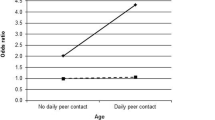Abstract
The present study was conducted in Finland and the USSR (Estonia) with two birth cohorts (14 and 17 years old) and their parents. The subjects, 504 in Finland and 329 in Estonia, were drawn from urban and rural areas. 85% of the Estonian and 55% of the Finnish parents returned the questionnaire. The results supported the hypothesis that adolescent drinking is an age-related behaviour aimed at active coping efforts to adopt adult-like behaviour. In both countries abstinence decreased with age, and the use of alcohol was seen as behaviour which became acceptable at an older age than the age when the actual initiation occurred. However, the use of alcohol remained occasional through the ages of 17 to 18. Adolescents’ drinking correlated strongly with their conceptions of the accepted motives for drinking which, in turn, correlated with observations of the parents’ use of alcohol. In Estonia, boys with high self-esteem were most active in adopting customary adult drinking. In Finland, drinking was typical of boys who were active in the use of leisure time, whereas abstinence, was typical of passive users of leisure time. The Finnish adolescents did not make a distinction between moderate and heavy drinking as clearly as the Estonian ones. Traditional sex differences in the use of alcohol still existed in Estonia, but Finnish girls’ drinking did not differ from Finnish or Estonian boys’ drinking. The influences of parental modelling were strongest for Finnish girls. There were few indicators of reactive coping efforts for strains from the environment, but a conflicted home atmosphere was a risk factor of the early onset of alcohol drinking.
Résumé
L’étude présentée a été effectuée en Finlande et en URSS (Estonie) auprès d’adolescents de 14 et 17 ans et de leurs parents. Les sujets (504 en Finlande et 329 en Estonie) proviennent de zones urbaines et rurales. 85% des parents estoniens et 55% des parents finlandais ont retourné le questionnaire. Les résultats confirment l’hypothèse que l’usage de boissons alcoolisées chez les adolescents est un comportement lié à l’âge, représentant une activité volontaire d’adoption d’un comportement semblable à celui de l’adulte.
Dans les deux pays l’abstinence décroît avec l’âge, et l’usage de l’alcool apparaît comme un comportement qui devient acceptable à un âge supérieur à celui des débuts effectifs de la consommation. Toutefois l’usage de l’alcool demeure occasionnel jusquá l’âge de 17–18 ans. L’usage de l’alcool par les adolescents corrèle étroitement avec leurs conceptions concernant les motifs admissibles pour la boisson, lesquelles, en retour, sont corrélées avec les observations concernant l’usage de l’alcool par les parents. En Estonie, les garçons ayant une haute estime de soi se sont montrés plus actifs dans l’adoption des habitudes de boisson des adultes. En Finlande, le fait de boire s’est montré typique des garçons actifs dans l’utilisation de leur temps libre, tandis que l’abstinence s’est montrée typique des utilisateurs passifs de leur temps libre. Les adolescents finlandais n’ont pas fait de distinction aussi claire que les adolescents estoniens entre un usage modéré et un usage intensif de la boisson. On a constaté que les différences traditionnelles dues au sexe dans l’usage de l’alcool existent encore en Estonie, mais les filles finlandaises ne se sont pas montrées différentes des garçons finlandais et estoniens.
L’influence des modèles parentaux s’est avérée importante dans le cas des filles finlandaises. On a relevé peu d’indicateurs relatifs aux pressions de l’environnement, mais une atmosphère familiale conflictuelle apparaît comme un facteur de risque favorisant le démarrage précoce de l’usage de l’alcool.
Similar content being viewed by others
References
Barnes, G. M., Farrell, M. P., & Cairns, A. (1986). Parental socialization factors and adolescent drinking behaviours.Journal of Marriage and the Family, 48, 27–36.
Barnes, G. M., & Welte, J. W. (1986). Patterns and predictors of alcohol use among 7–12th grade students in New York State.Journal of Studies on Alcohol, 47, 53–62.
Jessor, R. (1986). Adolescent problem drinking: Psychosocial aspects and developmental outcomes. In R. Silbereisen & K. Eyferth (Eds.),Development as action in context (pp. 241–264). Berlin: Springer.
Jessor, R., & Jessor, S. L. (1977.Problem behavior and psychosocial development. New York: Academic Press.
Labouvie, E. W. (1986). The coping function of adolescent alcohol and drug use. In R. Silbereisen & K. Eyferth (Eds.),Development as action in context (pp. 229–240), Berlin: Springer.
Narusk, A. (1985a). Opilane 85: vaba aeg, tubakas ja alkohol (Est.)Noukoqude Kool (10), 16–21.
Narusk, A. (1985b).Perekond ja kultuur. (Est.) Tallinn: Eesti Raamat.
Narusk, A. (1987).Perekonnasotsioloogiast: Pered, kus kasvavad teismelised. (Est.) Tallinn: Valgus.
Ojanen, M. (1985). Kasvatus ja minäkuva. (Finn.) Reports from the Department of Psychology, University of Tampere. Whole Nr. 139.
Pulkkinen, L. (1982a). Nuorten tupakointi ja alkoholin käyttö pitkittäistutkimuksen valossa. (Finn.)Publications of the National Board of Health, Finland. Health Education Series, Whole Nr. 2.
Pulkkinen, L. (1982b). The onset and continuity of smoking and drinking in adolescence.Acta Psychologica Fennica, 9, 11–30.
Pulkkinen, L. (1983). Youthful smoking and drinking in a longitudinal perspective.Journal of Youth and Adolescence, 12, 253–283.
Pulkkinen, L. (1986). The role of impulse control in the development of anti-social and prosocial behavior. In D. Olweus, J. Block & M. Radke-Yarrow (eds.),Development of anti-social and prosocial behavior: Theories, research, and issues (pp. 149–175). New York: Academic Press.
Pulkkinen, L., Kalavainen, J., Kangas, A., & Marin, M. (1987). Keskisuomalainen nuori: Päihteiden käyttö nuorten elämässä. (Finn.) Reports from the Department of Psychology, University of Jyväskylä, Finland (in press).
Silbereisen, R. K., & Noack, P. (1988). On the Constructive Role of Problem Behavior in Adolescence. In N. Bolger, A. Caspi, G. Downey & M. Moorehouse (Eds.),Person and Context: Developmental Processes. Cambridge, Mass.: Cambridge University Press (in press).
Author information
Authors and Affiliations
Additional information
The material for Finland was collected with the financial support of the Ministry of Social Affairs and Health as part of the project «Central Finland’s Youth».
Rights and permissions
About this article
Cite this article
Pulkkinen, L., Narusk, A. Functions of adolescent drinking in Finland and the Soviet Union. Eur J Psychol Educ 2, 311–326 (1987). https://doi.org/10.1007/BF03172618
Received:
Revised:
Issue Date:
DOI: https://doi.org/10.1007/BF03172618




